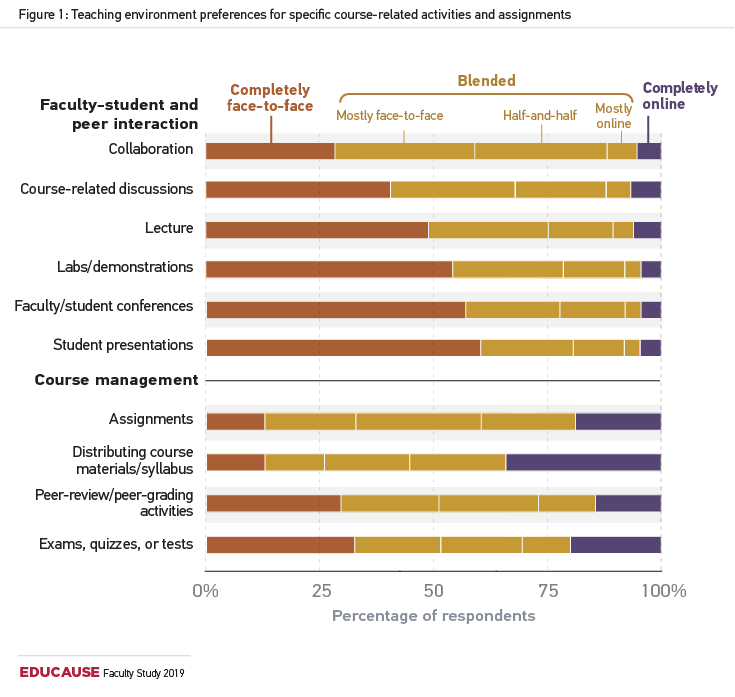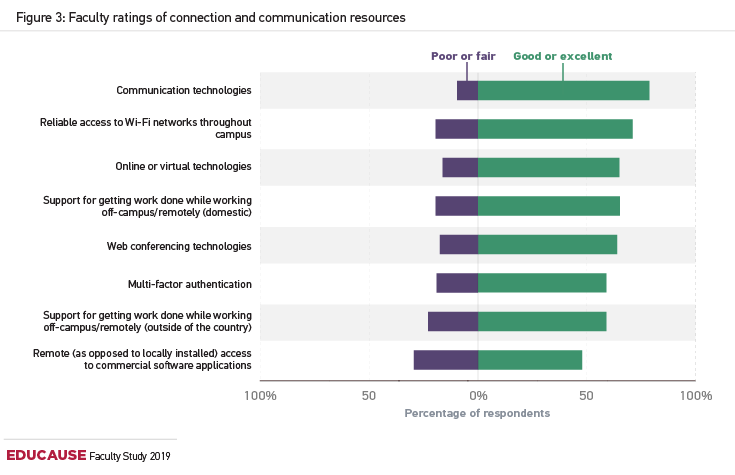Posts Tagged ‘Educause’
Designing Hybrid-Flexible (HyFlex) Courses to Support Multimodal Learning Environments
https://events.educause.edu/courses/2021/designing-hybrid-flexible-hyflex-courses-to-support-multimodal-learning-environments-3
badge earned for attending the course:
https://www.credly.com/badges/d115ce80-17a9-4238-8f7a-9e4cbc327114/linked_in
++++++++++++++++++++
Multimodal Learning Environments
https://ascilite.org/conferences/sydney10/procs/Sankey-full.pdf
Neuroscience research has also revealed that „significant increases in learning can be
accomplished through the informed use of visual and verbal multimodal learning‟ (Fadel, 2008, p. 12).
Multimodal learning environments allow instructional elements to be presented in more than one sensory mode (visual, aural, written). In turn, materials that are presented in a variety of presentation modes may lead learners to perceive that it is easier to learn and improve attention, thus leading to improved learning performance; in particular for lower–achieving students (Chen & Fu, 2003; Moreno & Mayer, 2007; Zywno 2003).
multimodal design, in which „information (is) presented in multiple modes such as visual and auditory‟ (Chen & Fu, 2003, p.350). The major benefit of which, as identified by Picciano (2009), is that it „allows students to experience learning in ways in which they are most comfortable, while challenging them to experience and learn in other ways as well‟ (p. 13). Consequently, students may become more self–directed, interacting with the various elements housed in these environments.
VARK learning styles inventory online to help determine their learning style (http://www.vark–learn.com/english/index.asp)
https://vark-learn.com/the-vark-questionnaire/
(see motivation theory: https://blog.stcloudstate.edu/ims/2021/10/14/motivation-theory/)
=================
more on hyflex in this blog
https://blog.stcloudstate.edu/ims?s=hyflex
Strategic IT Leaders Between Pandemic and Post-Pandemic
https://er.educause.edu/articles/2021/5/strategic-it-leaders-between-pandemic-and-post-pandemic
The effective IT leaders who made strong impressions on me when I was a president or provost were those who actively listened to non-IT discussions, asked clarifying questions, and—either in the moment or as a follow-up communication—
digital transformation (Dx). To help these efforts, EDUCAUSE has created a “Dx Journey Map.” It offers an elegant, visual way of telling the story of digital transformation to non-IT campus leaders.
++++++++++++++++
more on leadership in this IMS blog
https://blog.stcloudstate.edu/ims?s=leadership
https://library.educause.edu/-/media/files/library/2021/4/eli7177.pdf
- What is it?
- How does it work?
- Who’s doing it?
- Why is it significant?
- What are the downsides?
- Where is it going?
- What are the implications for teaching and learning?
++++++++++++++++++
more about digital divide in this IMS blog
https://blog.stcloudstate.edu/ims?s=%22digital+divide%22
Lischer-Katz, Z., & Clark, J. (2021).
Institutional Factors Shaping XR Technology Accessibility Policy & Practice in Academic Libraries. Survey. The EDUCAUSE XR (Extended Reality) Community Group Listserv <XR@LISTSERV.EDUCAUSE.EDU>.
https://uarizona.co1.qualtrics.com/jfe/form/SV_1Ya9id4uCXoktLv
participate in a survey is being sent out to those responsible for managing and providing XR technologies in academic libraries. This survey is part of a study titled “Institutional Factors Shaping XR Technology Accessibility Policy & Practice in Academic Libraries.” The principal investigator (PI) is Dr. Zack Lischer-Katz, PhD (Assistant Professor, School of Information, University of Arizona) and the co-principal investigator (Co-PI) is Jasmine Clark (Digital Scholarship Librarian, Temple University).
An Institutional Review Board (IRB) responsible for human subjects research at The University of Arizona reviewed this research project and found it to be acceptable, according to applicable state and federal regulations and University policies designed to protect the rights and welfare of participants in research
Please feel free to share this survey widely with colleagues.
Introduction
Over the past five years, many academic libraries have begun systematically integrating innovative technologies, including virtual reality (VR) and other “XR” technologies, into their spaces and services. Even though schools, libraries, and the library profession all stress equitable access to information and technology for all community members, accessibility – understood in terms of the design of spaces, services, and technologies to support users with disabilities – is rarely given sufficient consideration when it comes to the design, implementation, and administration of XR technology programs. Because XR technologies engage the body and multiple senses they show great potential for providing enhanced means for disabled users to access information resources; however, without accessibility policies in place, the embodied aspects of XR technologies can create new barriers (e.g., chairs and other furniture that cannot be adapted, controllers that cannot be adjusted for different degrees of dexterity, etc.)
Purpose of the study
The purpose of this study is to develop new understanding about the current landscape of accessibility policies and practices for XRtechnology programs and to understand the barriers to adoption of XR accessibility policies and practices.
The main research objective is to understand what policies and practices are currently in place in academic libraries and their level of development, the existing beliefs and knowledge of library staff and administrators involved with XR technology programs and spaces, and the institutional factors that shape the adoption of accessibility policies for XR technology programs.
The survey will be open from February 1, 2021 to April 30, 2021. More information regarding confidentiality and consent can be found at the beginning of the survey.
Please access the survey here:
https://uarizona.co1.qualtrics.com/jfe/form/SV_1Ya9id4uCXoktLv
Thank you in advance for your interest and participation,
Sincerely,
Zack Lischer-Katz, PhD, Assistant Professor, School of Information, University of Arizona; email: zlkatz@email.arizona.edu
Jasmine Clark, Digital Scholarship Librarian, Temple University; email: jasmine.l.clark@temple.edu
+++++++++++++
more on XR in this IMS blog
https://blog.stcloudstate.edu/ims?s=extended+reality
more on XR in libraries in this IMS blog
https://blog.stcloudstate.edu/ims?s=extended+reality+libraries
https://er.educause.edu/blogs/2020/12/key-findings-on-privacy-in-higher-education
report The Evolving Landscape of Data Privacy in Higher Education
Responses from the 2020 EDUCAUSE Student Technology report concerning student data privacy highlight a large gap of understanding that institutions need to bridge between student knowledge and administrative plans and policies
+++++++++++++
more on privacy in this IMS blog
https://blog.stcloudstate.edu/ims?s=privacy
Higher Education’s 2020 Trend Watch & Top 10 Strategic Technologies
D. Christopher Brooks Mark McCormack Ben Shulman Monday, January 27, 2020
https://library.educause.edu/resources/2020/1/higher-educations-2020-trend-watch-and-top-10-strategic-technologies
https://www.educause.edu/ecar/research-publications/higher-education-trend-watch-and-top-10-strategic-technologies/2020/introduction
Top 10 Strategic Technologies
-
- Uses of APIs
- Institutional support for accessibility technologies
- Blended data center (on premises and cloud based)
- Incorporation of mobile devices in teaching and learning
- Open educational resources
Technologies for improving analysis of student data
-
- Security analytics
- Integrated student success planning and advising systems
- Mobile apps for enterprise applications
- Predictive analytics for student success (institutional level)
At least 35% of institutions are tracking these five technologies in 2020: Support for 5G; Wi-Fi 6 (802.11 ax, AX Wi-Fi); Identity as a Service (IDaaS); Digital microcredentials (including badging); Uses of the Internet of Things for teaching and learning; and Next-generation digital learning environment
++++++++++
more on educause in this IMS blog
https://blog.stcloudstate.edu/ims?s=educause
2019 Study of Faculty and Information Technology
EDUCAUSE Center for Analysis and Research (ECAR)
https://library.educause.edu/resources/2019/12/2019-study-of-faculty-and-information-technology

Faculty satisfaction declines, but IT support is valued.

Faculty continue to ban student-owned devices, but is there a middle ground for effective learning?

++++
more on educause and faculty in this IMS blog
https://blog.stcloudstate.edu/ims?s=educause+faculty
https://www.edsurge.com/news/2019-12-11-most-students-and-faculty-prefer-face-to-face-instruction-educause-surveys-find
studies from the EDUCAUSE Center for Analysis and Research. The first, published in October, surveyed more than 40,000 students at 118 U.S. institutions, while the second, published this week, drew on data from 9,500 faculty members across 119 US institutions.
Among student respondents, 70 percent said they prefer mostly or completely face-to-face learning environments. The professors surveyed were even more partial to face-to-face classes, with 73 percent preferring them.
++++++++++++
more on F2F in this IMS blog
https://blog.stcloudstate.edu/ims?s=f2f
https://www.surveygizmo.com/s3/5155654/IT-Issues-2020?sguid=60122224
what i find most important:
Future IT Workforce: Deploying a broad array of modern recruitment, retention, and employment practices to develop a resilient IT talent pipeline for the institution
Digital Integrations: Ensuring system interoperability, scalability, and extensibility, as well as data integrity, security, standards, and governance, across multiple applications and platforms
Engaged Learning: Incorporating technologies that enable students to create content and engage in active learning in course curricula
Student Retention and Completion: Developing the capabilities and systems to incorporate artificial intelligence into student services to provide personalized, timely support
Administrative Simplification: Applying user-centered design, process improvement, and system reengineering to reduce redundant or unnecessary efforts and improve end-user experiences
Improved Enrollment: Using technology, data, and analytics to develop an inclusive and financially sustainable enrollment strategy to serve more and new learners by personalizing recruitment, enrollment, and learning experiences
Workforce of the Future: Using technology to develop curriculum, content, and learning experiences that prepare students for the evolving workforce
Holistic Student Success: Applying technology and data, including artificial intelligence, to understand and address the numerous contributors to student success, from finances to health and wellness to academic performance and degree planning (my note: this is what Christine Waisner, Mark Gill and Plamen Miltenoff are trying to do with their VR research)
Improved Teaching: Strengthening engagement among faculty, technologists, and researchers to achieve the true and expanding potential of technology to improve teaching
Student-Centric Higher Education: Creating a student-services ecosystem to support the entire student life cycle, from prospecting to enrollment, learning, job placement, alumni engagement, and continuing education
2019 Horizon Report
Tuesday, April 23, 2019 https://library.educause.edu/resources/2019/4/2019-horizon-report
https://library.educause.edu/-/media/files/library/2019/4/2019horizonreport.pdf
p. 8 Modularized and Disaggregated Degrees
Only 2% of institutions have deployed digital microcredentials (including badging) institution-wide, but 29% are expanding or planning their use. —EDUCAUSE Strategic Technologies, 2019
p. 15 Increasing Demand for Digital Learning Experience and Instructional Design Expertise
A driving factor for mobile learning is the ownership of mobile devices, particularly the smartphone. In 2018, the Pew Research Center reported that 59% of adults globally own a smartphone, and research from the EDUCAUSE Center for Analysis and Research indicated that 95% of undergraduate students own smartphones. As mobile device ownership and usage have increased, mobile learning is no longer just focused on asynchronous interaction, content creation, and reference. More emphasis is emerging on content that is responsive instead of adaptive and on creating microlearning experiences that can sync across multiple devices and give learners the flexibility to learn on the device of their choice
p. 25 Mixed Reality
p. 36 Fail or Scale: AR and MR –
In 2016, the Horizon Expert Panel determined that augmented reality and virtual reality were two to three years from widespread adoption. By 2018, the notion of mixed reality was, at four to five years from adoption, even further out.
p. 38 Bryan Alexander: Gaming and Gamification (Fail or Scale)
++++++++++++++
more on the Horizon reports in this IMS blog
https://blog.stcloudstate.edu/ims?s=horizon+report


